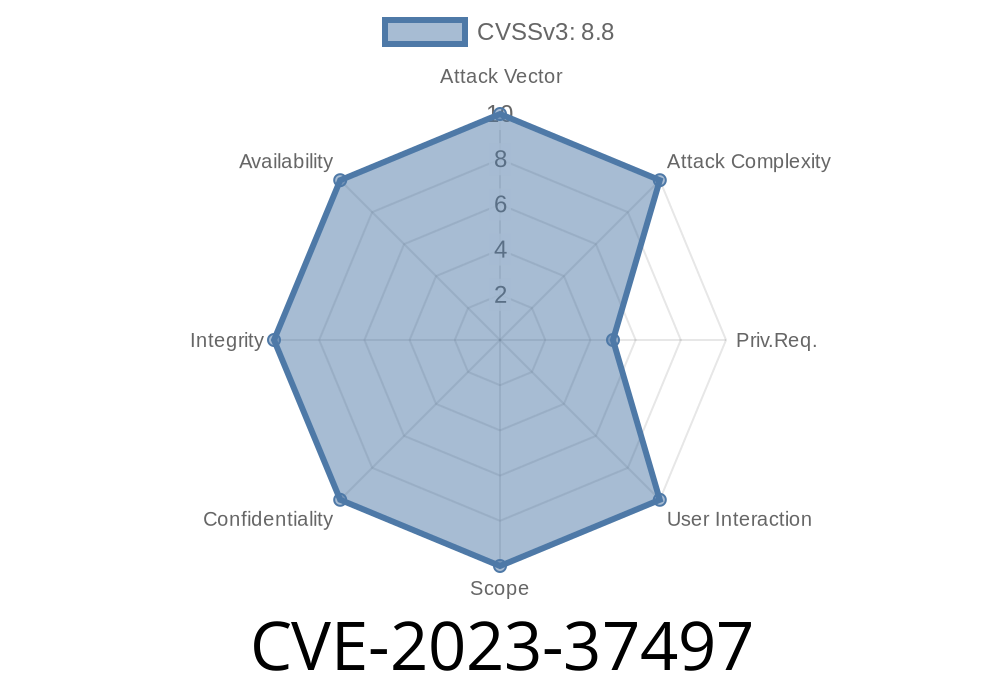CVE-2023-37497 is a recently discovered vulnerability in the Unica application that can potentially result in compromise of the targeted system. This security flaw has been reported by security researchers who have shown that an authenticated attacker with a specific set of rights can exploit this vulnerability to perform XML External Entity (XXE) attacks against the backend service.
This long-read post will cover the details of the vulnerability, outline the steps to exploit it, and provide code snippets to showcase the various components of the attack. We will also include original reference links to further complement the content and allow interested readers to dive deeper into the topic.
Overview of CVE-2023-37497
At the heart of the CVE-2023-37497 vulnerability lies the fact that Unica application exposes an API which accepts arbitrary XML input. This can allow an attacker to send malicious XML payloads, which, when parsed by the application, can result in compromises of the targeted system.
Vulnerable Component: Unica Application API (XML Interface)
Vulnerability Type: XML External Entity (XXE) Injection
Impact: Information Disclosure, Remote Code Execution, Denial of Service
Required Privileges: Authenticated user with specific rights
CVE-ID: CVE-2023-37497
XML External Entity (XXE) Attacks
To understand the vulnerability and exploit, it is essential to understand what an XXE attack is. XML is a widely used data format for representing and exchanging structured data. XML parsers often allow the XML documents to contain references to external entities, such as files on the local filesystem, which, when parsed, can result in the inclusion of external data into the XML document.
An XXE attack involves an attacker creating a malicious XML document containing carefully crafted external entity references that, once parsed, results in unintended actions or data exfiltration. Common XXE attack goals include reading sensitive files from the local filesystem or launching Denial of Service (DoS) attacks by loading large external entities.
Exploiting CVE-2023-37497
To exploit the CVE-2023-37497 vulnerability, an attacker must first be authenticated and possess specific rights within the Unica application. Once these conditions are met, they can craft a malicious XML payload containing external entity references.
Consider the following example of a malicious XML payload
<!DOCTYPE foo [
<!ELEMENT foo ANY>
<!ENTITY xxe SYSTEM "file:///etc/passwd">
]>
<foo>&xxe;</foo>
This XML payload defines an external entity named "xxe," which points to the "/etc/passwd" file on the local filesystem. When this XML document is parsed, the content of the "/etc/passwd" file is inserted into the resulting XML representation, effectively allowing the attacker to exfiltrate sensitive information.
An attacker can now craft the necessary HTTP request and submit the XML payload to the Unica application using the vulnerable API endpoint. This could be accomplished using a tool like curl or even a web-based API client.
curl -X POST -H "Content-Type: application/xml" -d @payload.xml http://example.com/unica/api/vulnerable-endpoint
Upon successful exploitation, the targeted Unica application will parse the XML payload, triggering the XXE attack and potentially resulting in information disclosure, remote code execution, or Denial of Service (DoS) attacks.
Conclusion
The CVE-2023-37497 vulnerability in the Unica application highlights the importance of proper input validation and secure coding practices when dealing with XML data. Ensuring that XML parsers are configured to disallow external entity resolution and validating the incoming XML data can go a long way towards mitigating XXE attacks in applications.
Original References
1. OWASP: XXE (XML External Entity) Processing_Processing)
2. MITRE: CVE-2023-37497 Detail
3. NVD: CVE-2023-37497 Detail
Timeline
Published on: 08/03/2023 22:15:00 UTC
Last modified on: 08/08/2023 14:49:00 UTC
